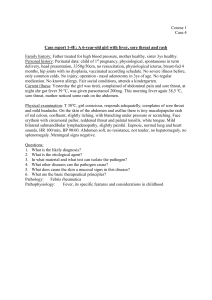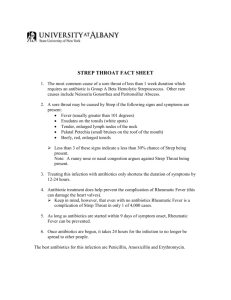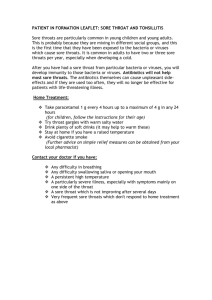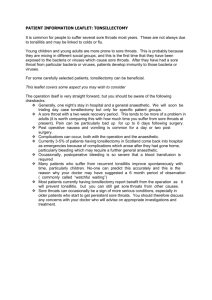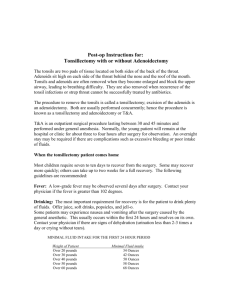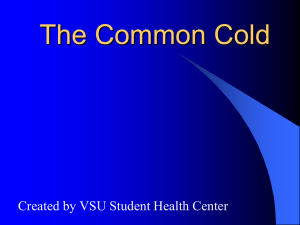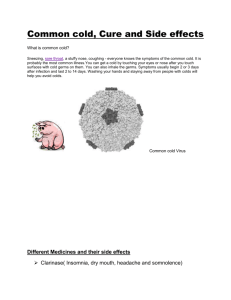Sore Throat & Tonsillitis
advertisement
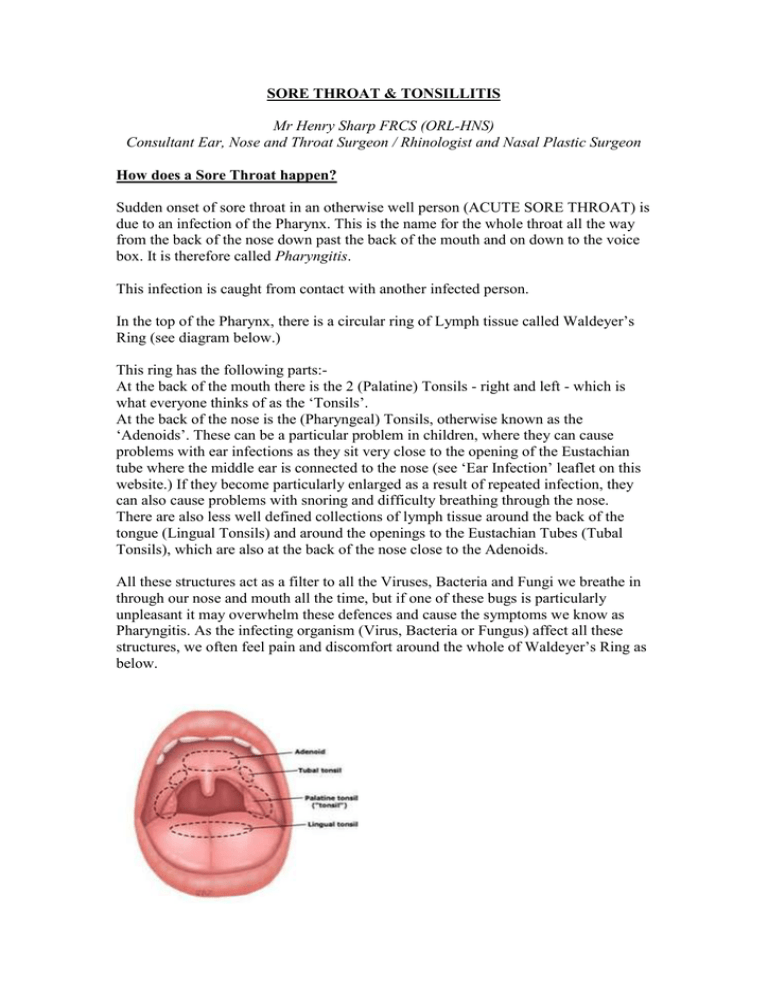
SORE THROAT & TONSILLITIS Mr Henry Sharp FRCS (ORL-HNS) Consultant Ear, Nose and Throat Surgeon / Rhinologist and Nasal Plastic Surgeon How does a Sore Throat happen? Sudden onset of sore throat in an otherwise well person (ACUTE SORE THROAT) is due to an infection of the Pharynx. This is the name for the whole throat all the way from the back of the nose down past the back of the mouth and on down to the voice box. It is therefore called Pharyngitis. This infection is caught from contact with another infected person. In the top of the Pharynx, there is a circular ring of Lymph tissue called Waldeyer’s Ring (see diagram below.) This ring has the following parts:At the back of the mouth there is the 2 (Palatine) Tonsils - right and left - which is what everyone thinks of as the ‘Tonsils’. At the back of the nose is the (Pharyngeal) Tonsils, otherwise known as the ‘Adenoids’. These can be a particular problem in children, where they can cause problems with ear infections as they sit very close to the opening of the Eustachian tube where the middle ear is connected to the nose (see ‘Ear Infection’ leaflet on this website.) If they become particularly enlarged as a result of repeated infection, they can also cause problems with snoring and difficulty breathing through the nose. There are also less well defined collections of lymph tissue around the back of the tongue (Lingual Tonsils) and around the openings to the Eustachian Tubes (Tubal Tonsils), which are also at the back of the nose close to the Adenoids. All these structures act as a filter to all the Viruses, Bacteria and Fungi we breathe in through our nose and mouth all the time, but if one of these bugs is particularly unpleasant it may overwhelm these defences and cause the symptoms we know as Pharyngitis. As the infecting organism (Virus, Bacteria or Fungus) affect all these structures, we often feel pain and discomfort around the whole of Waldeyer’s Ring as below. What causes Pharyngitis? In up to 80% of cases, Pharyngitis is due to a Virus associated with an Upper Respiratory ‘cough and cold’ type infection. It is therefore often associated with other typical viral symptoms such as raised temperature, muscle aches and feeling generally mildly unwell. These infections are usually short lived, and as a consequence of this many infections are self-limiting and DO NOT REQUIRE ANTIBIOTICS! Treatment is to relieve the symptoms by painkillers and temperature- lowering drugs such as Paracetamol and Aspirin (not in Children) or Aspirin-like drugs (NSAIDs) such as Ibuprofen, although these should be avoided in Asthmatics. Topical Anaesthetics given as sprays or mouthwashes (e.g Difflam) may also help by numbing the throat. Bacteria also cause sore throat, but tend to give worse symptoms and occur in younger adults and children (i.e less than 15 years old.) To help you distinguish whether your Acute Sore Throat is viral or bacterial, people with bacterial sore throat infections have a higher chance of having other symptoms as well, such as: - Cough - Enlarged painful lymph glands in the neck - High temperature - Swollen or mucky looking Tonsils (as in picture below.) These patients with more severe symptoms (indicating that the infection may well be due to bacteria) are far more likely to benefit from treatment with antibiotics. Fungi can also cause sore throat, but this is more unusual in normally healthy people. It can, however, be seen in people who use steroid inhalers for asthma, and don’t wash their mouth out thoroughly after their use. Whatever the cause, Acute Sore Throat may mainly affect the Nose (Nasopharyngitis, which is usually what happens in the Common Cold) or the Tonsils (Pharyngotonsillitis) which is where they may be pain and a pussy appearance around the Tonsils at the back of the mouth (commonly called Tonsillitis) as below. Rarely, inflammation of the Tonsils like this can be associated with other more severe specific viral infections such as Glandular Fever, which affects the Lymph Tissues throughout the body, of which Waldeyer’s ring and thus the Tonsils are of course only part. Sometimes a severe episode of bacterial tonsillitis can lead on to the formation of an abscess (a collection of pus, like a boil) next to the tonsil at the back of the mouth called a Quinsy (not Quincy, who was a TV Detective in the 1980’s!) Unless caught very early, a Quinsy needs a small operation to lance and drain it. This can usually be performed by an ENT Specialist with you awake using some numbing spray and/or a small injection of Local Anaesthetic, but it may then require a day or so in hospital afterwards. If you have more than 1 episode of Quinsy in conjunction with Tonsillitis, then Tonsillectomy is probably required. What causes Chronic Sore Throat? If the sore throat continues for a prolonged period or doesn’t have the characteristics of an infective cause as described above, then the Sore Throat is described as ‘Chronic.’ If this is the case, then other causes should be sought by your GP, usually with the help of an ENT Specialist such as myself. Common causes of this issue include long standing Acid Reflux, whereby acid is coming up from the stomach into the back of the throat causing constant irritation there (see ‘Swallowing Difficulty and Laryngopharyngeal Acid Reflux’ leaflet on this website.) Long standing issues of Rhinitis and Sinusitis (inflammation and infection in the nose and sinuses) with infected mucous dripping down the back of the throat can also cause chronic sore throat. (see ‘Rhinitis / Sinusitis and Nasal Polyps’ on this website.) Sometimes, food debris and secretions called Tonsilliths may collect in particularly pitted tonsils, causing soreness, infection and bad breath. Lastly, but very importantly, a small percentage of people with persistent constant sore throat may have a throat cancer. This is more common in smokers, particularly those who also overindulge in alcohol. If your sore throat lasts for more than 6 weeks, you should seek an appointment to see me or one of my ENT Colleagues for a thorough examination of your throat! Do I need my Tonsils out (Tonsillectomy)? Tonsillectomy is the operation to remove the (Palatine) Tonsils (please see information leaflet on ‘Tonsillectomy’ on this website.) It is only needed if the sore throats you or your child are experiencing are recurrent (causing time off work or school) and / or severe and constant (sometimes called ‘Chronic Tonsillitis’.) The tonsils may also cause other problems due to their sheer size, and this issue may also require Tonsillectomy to be carried out (see below.) For your interest, I have therefore listed the 2015 Kent and Medway NHS Criteria for Tonsillectomy to be performed here:-5 or more documented episodes of sore throat per year, with problems for a year or more. -Episodes of sore throat must be ‘disabling and prevent normal functioning’. -2 or more episodes of Quinsy. -Severely enlarged tonsils, causing blockage of the airway and breathing or Obstructive Sleep Apnoea while asleep (see ‘Snoring and Obstructive Sleep Apnoea’ on this website.) If you think you or your child fulfil any of these criteria, then you may benefit significantly from Tonsillectomy. Please note that Tonsillectomy for problems with Tonsilliths and with more nonspecific ‘Chronic Tonsillitis’ (these 2 issues may well coincide) is not covered by the NHS, but is something I can offer Privately. Sometimes (particularly in children) Tonsillectomy is combined with removal of the Adenoids (Adenoidectomy – see ‘Adenoidectomy’ leaflet on this website.) The other parts of ‘Waldeyer’s Ring’ are not removed during Tonsillectomy, but do not generally cause problems like the true ‘Palatine’ Tonsils. Following Tonsillectomy, you will still get sore throats with any respiratory infections like all the rest of the population, but you will not get Tonsillitis. You will therefore not get the severe throat symptoms of pain and inflammation during bouts of Tonsillitis that you had before. If there were problems with airway blockage due to the physical size of the tonsils prior to Tonsillectomy, these will be cured, however – the tonsils do not grow back! There is no evidence that Tonsillectomy has any effect on the ability of you or your child to resist or fight infection in the future. Indeed, by the time they are removed in appropriate patients, the tonsils themselves are a hive of infection that your body can never get fully rid of and which themselves are actually causing the repeated sore throat and tonsillitis.
